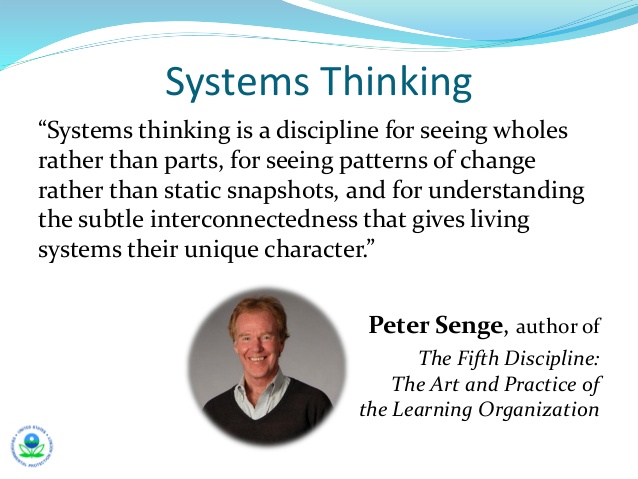As Peter Senge mentions in The Fifth Discipline, ‘most of the problems faced by humankind concern our inability to grasp and manage the increasingly complex systems of our world’ (Senge, 1990: 14).
Capra and Pauli also emphasize the need for systems thinking when it comes to solving the problems of our times: ‘The more we study the major problems of our time, the more we come to realize that they cannot be understood in isolation. They are systemic problems – interconnected and interdependent’ (Capra and Pauli, 1995:2).

Systems thinking for environment and sustainability
What does it mean to look at environmental or sustainability issues from a system point of view?
First of all, it is important that we start seeing the Earth as a system in which all parts are connected and influence one another. The environmental problems of our time are not isolated events, but systemic breakdowns that require new and innovative solutions. Companies, NGOs and public institutions need to go beyond symptomatic solutions that are not addressing the source of the problems and, through system thinking, learn to find leverage and create long-term and system-level changes.
Finding the source of the problems and leverage
An important step in developing a systemic approach is to find the source of the problems, as this increases the chances to see where the leverage lies. In The Fifth Discipline, Senge describes leverage as a small, focused action, that can produce significant change with a minimum effort if it is taken in the right place. Leverage can also be achieved by weakening the symptomatic response to the problem (that only treats the symptoms), while strengthening the fundamental solution (that treats the root causes) (Senge, 1990).
But what does it mean in practice to have a systemic approach? Here are 3 simple examples related to environment and sustainability:
Flood protection measures
Preserving and restoring wetlands, that act as a natural sponge during floods, instead of building more dams, is an example of systems thinking. The real source of the problem is identified (e.g. the loss of wetlands) and the symptomatic solution (e.g. building more dams) is replaced with the fundamental solution (e.g. preserving existing wetlands and restoring those that were lost, degraded or drained).
Building sustainable companies
The road of a company towards sustainability is a complex process that requires systemic thinking and shared vision in order to develop capacity for change and sustainability learning at all organizational levels. In order to become sustainable, companies need to embed sustainability principles in the core business areas (product development, operations, human resources, supply chain etc.).
Failing to integrate sustainability into business DNA leads to corporate duplicity and situations when one section of a company is considered sustainable, while another might attempt to avoid environmental legislation. For example, a company gains recognition for its environmentally friendly products, but at the same time is accused of causing environmental injustice in the developing world. The non-systemic thinking related to sustainability also creates a workforce that is not entirely tuned to the mission statement of the company (Frankel, 2001).
Implementing environmental & nature conservation projects in local communities
Many environmental & nature conservation projects are based on a unilateral approach, as they advance ideas and solutions that mainly represent the vision of the NGOs or institutions that propose and implement the projects. Not having integrated the needs or interests of the local communities could lead to the lack of cooperation from local stakeholders and failure in achieving the project goals.
A systemic approach in this case would consist in actively engaging with the local communities (before, during and after the project) and finding the fundamental problems that prevent them from acting sustainably or protecting the environment. If it’s poverty, helping the local communities develop alternative economic models will increase their openness to environmental protection initiatives. If the fundamental problem is the lack of education and awareness regarding the link between their lives and the environment, then it is crucial to engage with all the key stakeholders in the community (schools, farmers & hunters, local business representatives, church, households, local authorities etc.) through tailor-made actions and programs.
References
Capra, F. and Pauli, G. (ed.) Steering Business Toward Sustainability, Tokyo: United Nations University Press.
Frankel, C. (2001) ‘Mixed Messages’ in Starkey, R. and Welford, R. (ed.) Business & Sustainable Development, London: Earthscan Publications Ltd.
Senge, P.M. (1990), The Fifth Discipline, London: Random House.












I know this website gives quality dependent posts and extra material, is there
any other website which provides such data in quality?